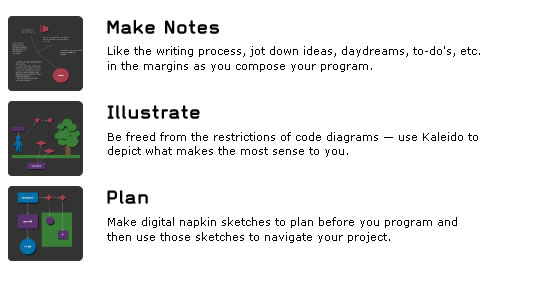Kaleido Demo from Agnes Chang on Vimeo.
Part of the beauty of working with code is that it can refine the way you think, challenging you to make design ideas into systems. But what’s often a challenge for beginners – heck, sometimes even for experienced coders – is thinking through the ways in which component parts function and combine.
We’ve seen code systems and visual patching systems, but Kaleido is something a bit different: it uses visual diagrams to loosely reinforce ideas in the code. Because it’s not rigidly attached to the code, you can use it to sketch out thoughts. But if you like, you can also attach sections of code to color-coded modules and immediately jump to bits of code from the visual interface, combining some of the best of visual programming and textual programming.
Kaleido works with Processing, adding an extra, visual pane to the standard Processing IDE. It’s the work of the Design Ecology Group at the MIT Media Lab and a Masters’ Thesis for Agnes Chang.
The always-wonderful designplaygrounds covered the technology recently, found via Processing co-creator Casey Reas:
Kaleido
In my own teaching, I try to emphasize object-oriented coding as early as possible. For me, it most neatly and nearly approximates the way we intuitively think about conceptual problems in general. It helps to systematize design. I’m not entirely sure Kaleido would work perfectly for me in the object-oriented workflow, if only because it seems to assume blocks of code, linearly, define function, rather than inheriting the relationships you create in classes. In fact – speaking to more advanced coders for a moment – maybe there’s a chance to do a sort of UML-for-artists tool that feels more creative and less like a computer engineering project. And I still like using Eclipse. But I could see Kaleido being a lovely addition to the Processing sketchbook, even in my work; I’ll have to give it a try.
Oh yeah, and someone has to try porting it to a non-Mac environment. (That should be eminently doable, by the way.)
The Processing IDE is entirely extensible. If you’re interested in customizing the coding experience yourself, there’s a terrific how-to video by sojama (Andreas Schlegel), just posted, that shows you how. See also his excellent new tutorial for making libraries in Eclipse, too.
processing-tool-template setup from sojamo on Vimeo.
